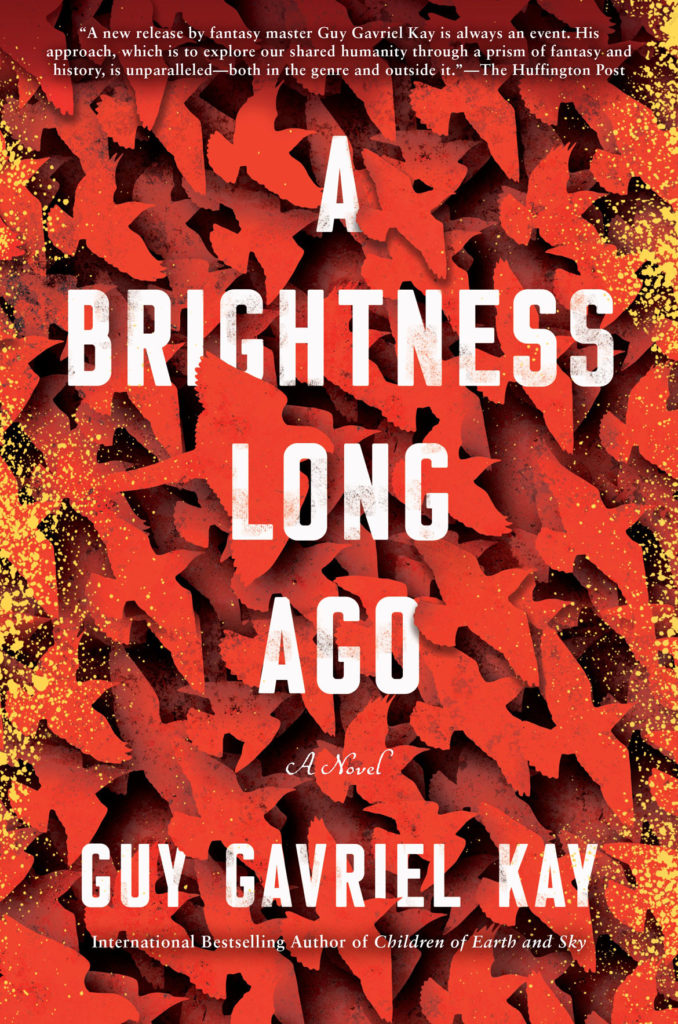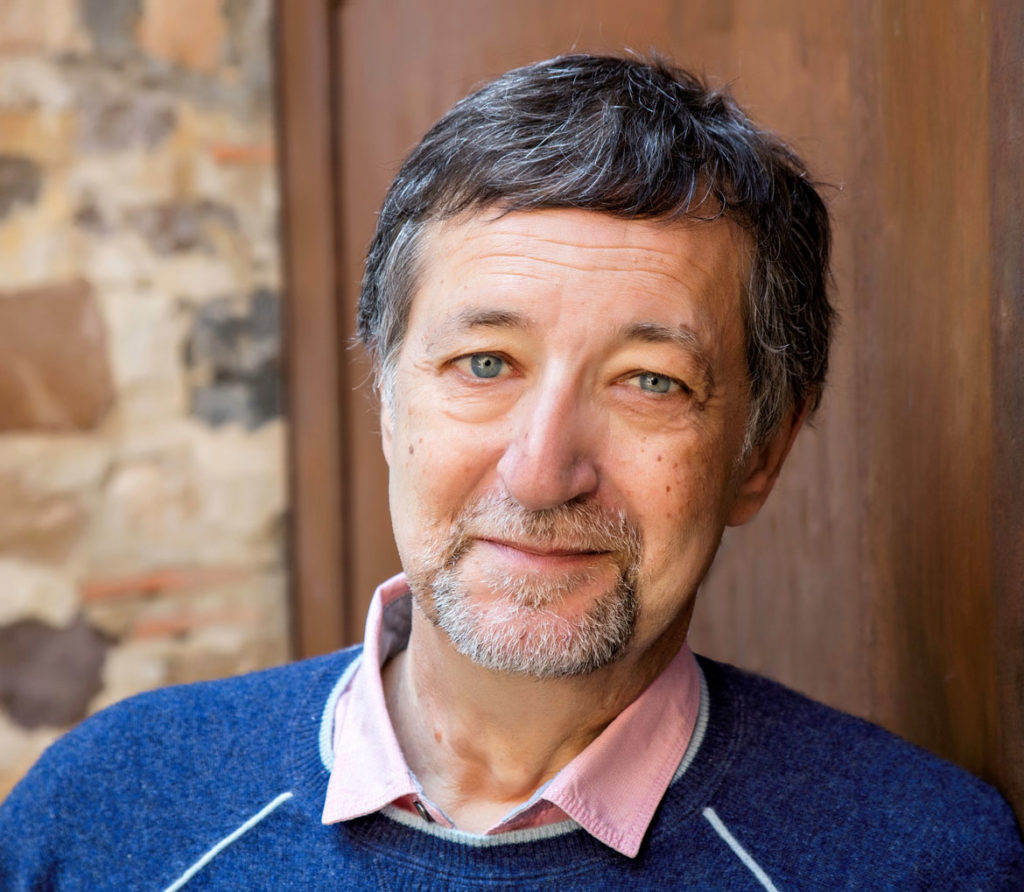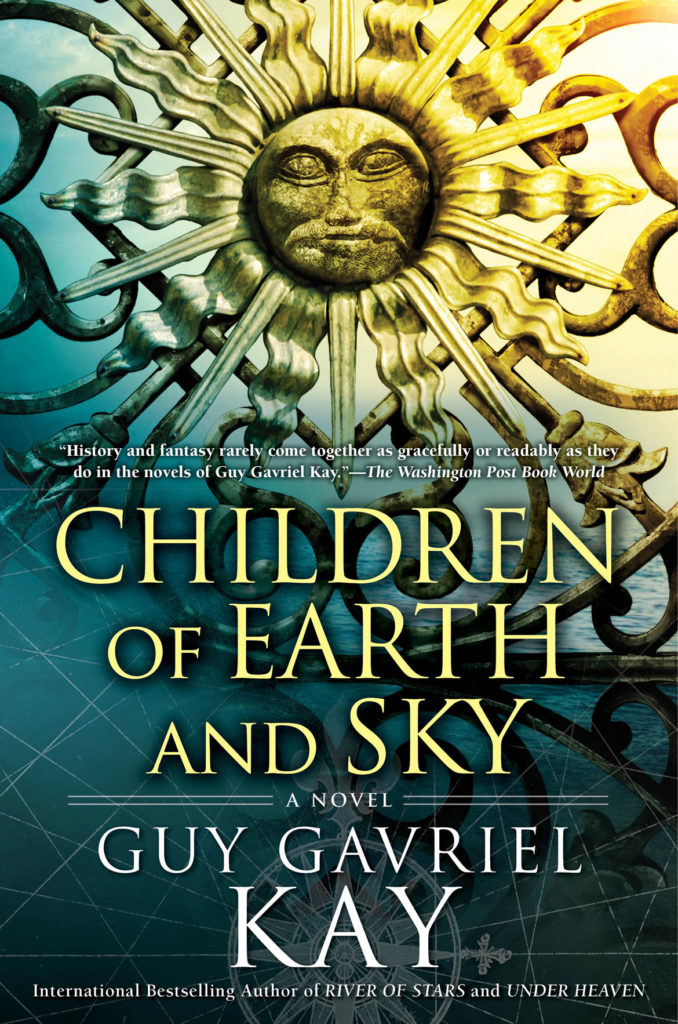In Guy Gavriel Kay’s latest novel “A Brightness Long Ago” (due out from Viking May 14), Count Uberto, dubbed “The Beast,” has his men scour his kingdom for young women and boys to, ahem, entertain him. Some he sends home afterward scarred. Some never arrive home. Tonight, a steward recognizes the farm girl they bring in, but says nothing. She is in fact an assassin who has been carefully inserted by a more powerful warlord with designs on the kingdom.
So begins Kay’s sumptuous new historical epic. This one is set in a reimagined constellation of early Renaissance Venice, Constantinople and city-states sprinkled between. It returns to the territory of his last novel, “Children of Earth and Sky,” but some decades earlier.
As usual, Kay populates “A Brightness Long Ago” with riveting characters—the assassin endeavoring to outrun the sexist strictures of her society (a recurring theme in Kay’s books), the steward who aids her escape, a mystical pagan healer, a wayward prince, a mistress angling to be queen, plus the assassin’s boss and a rival warlord-mercenary who have been snarling at each other for decades over an old family feud.

Kay began his publishing career in a barn in Oxford, England. There in 1974 and 1975, he helped Christopher Tolkien assemble 1977’s “The Silmarillion” from scraps and drafts of Middle-earth tales that his father, J.R.R. Tolkien, left behind at his death in 1973. Afterward, Kay returned to Canada, studied law at the University of Toronto, labored on a novel, then found employment writing for a Canadian radio series dramatizing true crime tales.
The 64-year-old Toronto author published the first of his 14 novels in 1984. (There’s also a volume of poetry.) He came to fame via his “Fionavar Tapestry” trilogy, beginning with “The Summer Tree,” which were rooted in Arthurian legends.
With his 1992 novel “A Song for Arbonne,” set in medieval France, Kay began mining history with “a quarter turn to the fantastic” (a phrase he borrowed from a reviewer). Except for 2010’s “Under Heaven” and 2013’s “River of Stars,” inspired by Chinese dynasties, Kay has primarily explored European history across a millennium, from roughly the 6th to 15th centuries.
Kay’s novels are as interested in the machinations of politics as with espionage, chases, battles. Kay’s “quarter turn to the fantastic” allows him to draw on thrilling historical accounts but take liberties. He gives the true-life personages and places new names. He imagines people’s drives and passions. He condenses timelines. This helps give his novels the rich detail of life while also the narrative propulsion of romantic, action adventures. (For example, everyone has great sex.)
“A Brightness Long Ago,” like many of Kay’s novels, is both magisterial and wistful because he zeroes in on historical turning points, in this case the decline of the Byzantine Empire and the rise of the Ottoman Empire. Other novels have looked from the waning Vikings to the rise of Saxon England, from the fall of Muslim kingdoms of the Iberian Peninsula to the establishment of Christian Spain. They become stories reckoning with loss—of loves, of kingdoms, of eras.
Kay kindly responded to a series of questions I sent by email. (Note: I’ve moved the Tolkien question to the top. Also, my questions were all submitted at the same time, which is why some of my follow-up questions seem oblivious to Kay’s answers.)

If this is the kind of coverage of arts, cultures and activisms you appreciate, please support Wonderland by contributing to Wonderland on Patreon. And sign up for our free, weekly newsletter so that you don’t miss any of our reporting.
Greg Cook: What did you learn from Tolkien? How has what you taken from the experience of working on “The Silmarillion” affected you? When you were starting out? Now?
Guy Gavriel Kay: There were (and are) many legacies for me from that year. (I could get elegiac!) One was a crystallization of my desire to be a writer. I expected to become a criminal lawyer to make a living, but I knew from that year what I’d want to do most. One major specific ‘lesson’ from the Tolkien year was realizing how many false starts and outright errors exist in the early stages of even a masterpiece. It was a gift to me, understanding that a bad draft was not a death sentence to a work. That you just stayed with it, thought more, revised, worked harder. Later, once established, I began to implement another thing I learned from his papers: Tolkien was unfailingly courteous and responsive to readers, even when their worldviews might be alien to his. He wrote back steadily, even as he aged and the volume of mail grew enormous (a secretary was assigned to help with this). It was a fine example set, to have seen this.
Cook: Could you talk about the historical underpinnings of “A Brightness Long Ago”?
Kay: “Brightness” is inspired by people and events and themes of the early Renaissance in Italy. In particular, a long feud between Federico Montefeltro of Urbino and Sigismondo Malatesta of Rimini, probably the most coveted (as mercenaries) and feared military commanders of their time. But, as I have done for years, I do a ’20 degree turn to the fantastic’ (for many reasons), so we are in ‘Batiara’ not ‘Italy.’ That idea of being inspired by, not trying to assume actual knowledge of the innermost thoughts of real people is central to my body of work.
Cook: It’s a prequel to “Children of Earth and Sky” with some of the same characters, right? Why did you decide to come back to these people and this time/milieu?
Kay: I don’t think in terms of sequels and prequels, because it implies the necessity of knowing another book, and it is simply not so here. I do have what I call ‘grace notes’ (the cool kids call them ‘Easter eggs!’), small nods from one book towards another, and I’ve done this, too, for years. Many writers do it, without assuming or requiring a reader knowing earlier books. As to the ‘why’ of this time … it is an astonishingly rich and fertile period for themes and events that resonate for me … and I suspect for many others today.
Cook: Why do you like writing these non-linear sequels/prequels? Similarly with your China novels.
Kay: Same answer as above, I don’t think of them that way … the two books inspired by China take place about 300-400 years apart! It would be like calling a book about the Tudors a ‘sequel’ to one about the Norman Conquest! Entirely different periods and issues. I simply became really interested in the Song Dynasty after finishing a book about the Tang.

Cook: Your novels often focus on historical turning points–particularly the falls of kingdoms and empires. Chinese dynasties, Muslim Spain, decline of the Vikings, and in this case, the fall of Constantinople. Why are you drawn to write about these turning points—these endings?
Kay: I think this is true about what draws me. I think times of transition, with the tension (often warfare) and drama associated with them are really rich from the point of view of someone engaged by the past. One theme that recurs for me is how those ‘great events’ may not be the main concern of ordinary people — who are more likely to be trying to ‘get on with their lives’ as conflict and upheaval sweep past or over them.
Cook: What do we learn from these turning points? What do we learn from such endings, losses, failures? What do learn from aftermaths, from life continuing on?
Kay: What an interesting, huge question! I’m going to say that we learn different things from different stories. It is not all the same. The lessons vary.
It can be a mistake to forget the past (condemned to repeat it) but also a mistake to ‘fight the last war.’ I love the great quote ‘history does not repeat, but it rhymes.’ (It is attributed to Mark Twain, but it is unlikely he actually said it.) I like finding the rhymes in history, and letting readers shape their own responses and conclusions. I have said for years that writing fiction is a dialogue not a monologue … readers bring their own taste, mood, stage of life to the interaction, and that matters enormously. We’ve all had the experience of disliking a book, then trying it again a decade (or a year!) later and loving it. Ands the opposite applies, too, a book that slays us at 15 may make us feel wry about our youthful passion at 50!
Cook: It seems throughout your career, and especially in your recent novels, that your major characters are women—generally women struggling to overcome/escape the confines of male-dominated societies. Why do you highlight these characters? Why do you want to create/tell their stories? Fantasy writing is changing, but it’s long been centered on male characters. Why have you long wanted to put women at the center of your stories?
Kay: My formal links to the norms of fantasy are pretty small, though I’m immensely grateful that readers of the genre seem to like my work. I have no genre-related crusade at all. I want to write about interesting (compelling?) people in interesting situations and times in language that engages and moves readers of all kinds. This means that the women as well as the men need to be as vividly drawn as I can manage.
Any reading of history will show how constrained the lives of women were in almost all periods, and I like to show characters pushing back (plausibly, I hope) against those constraints. My research, which is always slow (and my favorite part of writing a book!) gives me examples I seize upon: a female doctor in medieval times, a great (great!) Chinese woman poet in the Song Dynasty (Li Qingzhao), Alfred the Great’s magnificent daughter Aethelflaed, the fact that a woman did once race in Siena’s famous Palio… when I find these stories it is as if a gateway opens, permission is granted…
Cook: Beginning with “A Song for Arbonne” most of your novels (except the China stories) have been set in Europe. Together they end up being an epic take of this period in European history, perhaps about the rise of European city-states into nations and their clashes with neighboring powers. What would you say that Europe is about? What were the major changes? What are the meanings of that time and those changes?
Kay: Well, again, we are covering a very wide range of periods that have inspired me and the themes always vary … the 6th century in Byzantium, the time of King Alfred and the invading Vikings, El Cid in 11th century in Spain, medieval Provence and the ‘crusade’ France launched down the Rhone Valley, two very different periods in Chinese history, to the Renaissance inspiration of the last two books (with a detour to modern-day Aix en Provence in “Ysabel”!). So I can’t actually offer some grand unified field theory. I don’t think or write that way. I try to look at a given period and see what engages me there, what characters compel me, in the hope I can make this engaging for readers.
Cook: Another theme that arises in your fictionalized Europe is the clash of religions—Christian, Muslim, Jewish, Norse. What does this tell us about how religion drives people, drives kingdoms? What is it about religion that defines peoples so? How does this benefit/fuel your stories?
Kay: L.P. Hartley wrote ‘The past is a foreign country; they do things differently there.’ (First sentence of “The Go-Between.”) One thing that needs to be registered by us is the power of faith driving people in different times and places, sometimes not in a good way, as we seen in the wars and crusades it has shaped. In medieval Europe, for example, people did see themselves as treading a narrow path to avoid eternal damnation. In a largely secular society, it is important (and challenging) to try to lay out this aspect of life in the past (without overplaying it in a story, too — the balancing act). As you noted above, I’m also drawn to societies on the cusp of change and conflct, and religion has often triggered those changes and conflicts.
Cook: You’ve spoken often of your method of telling history with a turn to the fantastic. So I won’t get into that deeply in these questions. But what do adding ghosts, seers, witches, myth and fable into the mix give you? What do they add? At times it seems like you’re taking faiths literally, at their word.
Kay: That is a sharp observation! I’ve done speeches and essays on this, too, so the brief version will oversimplify, but here’s a try! I think one problem with a lot of historical fiction is that it embeds or elicits a certain smugness in modern readers. ‘Can you believe they actually thought in 6th century Byzantium that inscribed wax curse tablets worked!’ or ‘Seriously? In Tang China they thought ghosts of dead people lingered until they were properly buried?’ Which leads too often to: we know so much better! This creates not just that whiff of superiority but also of distance between reader and the characters. I find one strength of deploying this small element of the fantastic is that it makes the world be as the characters believe it to be. If I do it right, this can erode (or even erase?) that sense of distance.
I’ll add this: years and years after I’d begun doing this, I saw a definition of magical realism in a biography of Gabriel Garcia Marquez, and it said exactly this. That the form or genre involved making the world really be as the characters saw it, without any sense that the author (or reader) saw this as ‘quaint.’ (That was the word used!)
I’d often said, long before this, that ‘magic realism’ was a label literary readers used to describe a book they admired when ‘fantasy’ or ‘the fantastic’ would work, too, but didn’t have the same cachet. I see the fantastic as a tool in the writer’s toolbox, like so many others, to be deployed as the needs of a given book suggest.
Cook: Artists, poets and singers are often major characters. They’re often artist-kings or poet-warriors. What does that artist perspective add to your stories?
I’ve always been interested in the shifting, ambivalent relationship between art and power. The way artists can challenge power or embrace and support it — or rely upon it to survive, as with the patronage of the Renaissance, or the Celtic poets with their kings, or Chinese poets and their interaction with those in power.
In “Sailing to Sarantium” evoking 6th century Byzantium I wrote a conversation between a mosaicist and a general about this, where the general points out the artist’s desire to make something that endures turns, in good part, on the general’s ability to defend and protect it from enemies and destruction. We’ve seen a lot of art and architecture destroyed in our time, so the point remains, I think. At the same time, the role of challenging those in power, the status quo, is also a recurring, vital component of art through the ages. So I suppose what this all adds for me is another layer of conflict and complexity! I am hostile to oversimplifications, I guess.
Cook: How do you balance the statecraft and the action in your books? Your stories are both savvy about the machinations of politics and filled with thrilling espionage, chases, battles. Why do you like having both in your stories?
Kay: On the most basic level, I think we write the books we’d like to read if someone else wrote them. I enjoy novels that contain or explore this balancing. I have never accepted the bland dichotomy between genre and literary fiction, where the former is allegedly all about plot, and the latter about character and language. Dammit, I’ll say it is my job to try to deliver all three of these. And our jobs can be difficult. Difficulty is in the game, it’s fair enough. Doesn’t mean we can’t aspire.
I also prefer the stiletto to the bludgeon (as a reader, too), so I don’t want to smash readers over the head with the themes and motifs of a book, I want them turning pages till three in the morning for the story, to find out what happens next but then being reminded of a book by Kay a year or ten years later, when something happens now (in the wider world or their own life) that brings an echo of something they read in my fiction.
Cook: How does your age shape your novels these days? “A Brightness Long Ago” feels nostalgic, elegiac—an old man remembering loves and adventures of his youth. Is that how you’re feeling yourself these days? How has your writing and the stories you’ve wanted to tell changed over the years?
Kay: We have to be careful about calling Guidanio ‘old’ as he’s in his 40s as he looks back. Yes, lives were shorter, but he wouldn’t necessarily have seen himself as old yet! I think a book built around such memories will definitely evoke a feeling of the elegiac, and I was going for that, in part in this story.
Having said that, you are quite right that tone and mood can change, not just from book to book, but as a writer changes. I think if we are the same person and writer at 60 that we were at 30 something has gone wrong in our growth — as a person and as an artist. We should be altered by our experiences. I know I have been. My father’s death, the birth of my sons, simply the accumulation of experiences… these will affect us, and that just about has to affect what we want to say in our work, if we are serious about that work. I don’t think there’s necessarily a through line — that older writers do nostalgic books — but I think that changes will be there to be seen in artists we admire. Look at Rembrandt’s self-portraits!
Related: How Tolkien Envisioned ‘The Hobbit’ And ‘Lord Of The Rings’
If this is the kind of coverage of arts, cultures and activisms you appreciate, please support Wonderland by contributing to Wonderland on Patreon. And sign up for our free, weekly newsletter so that you don’t miss any of our reporting.
